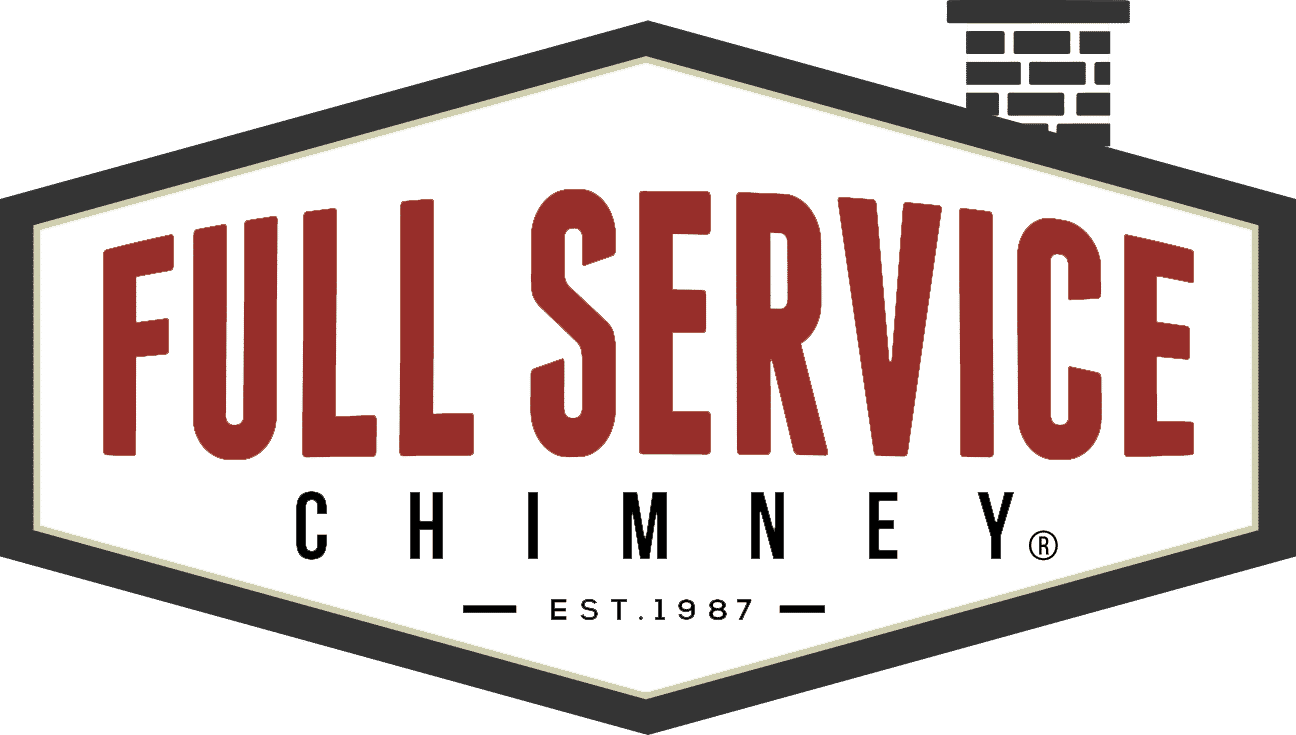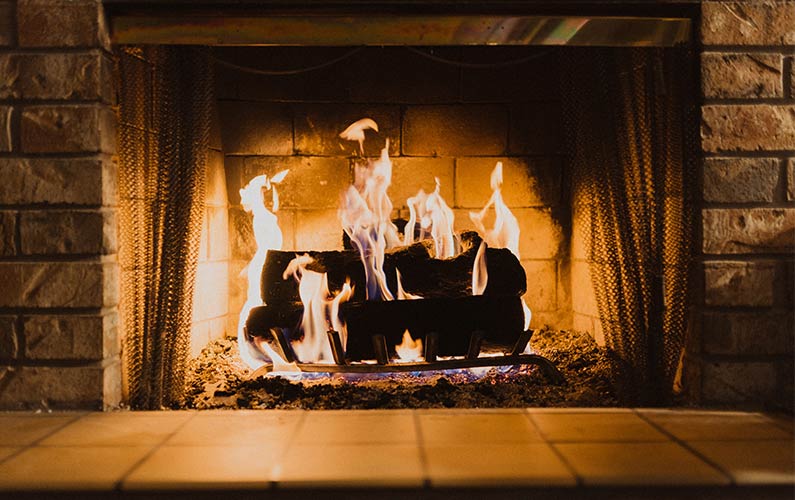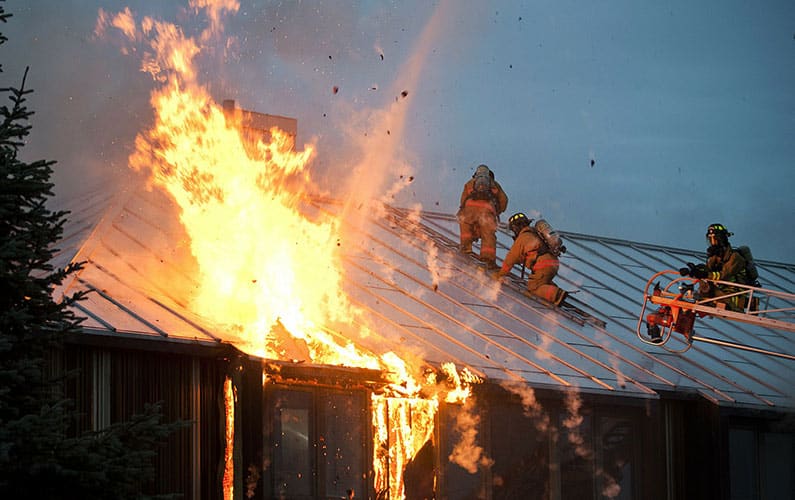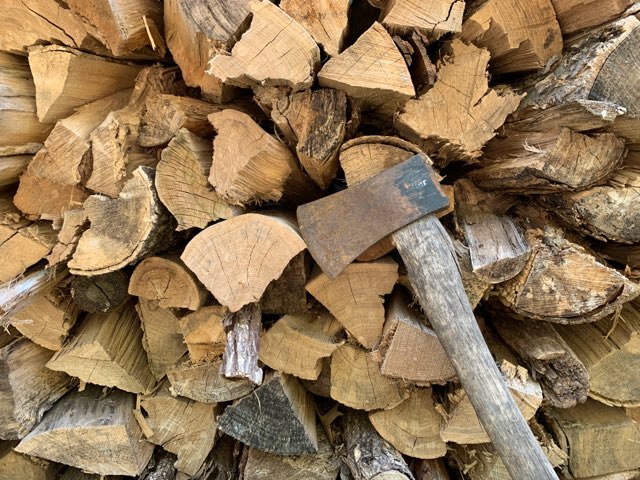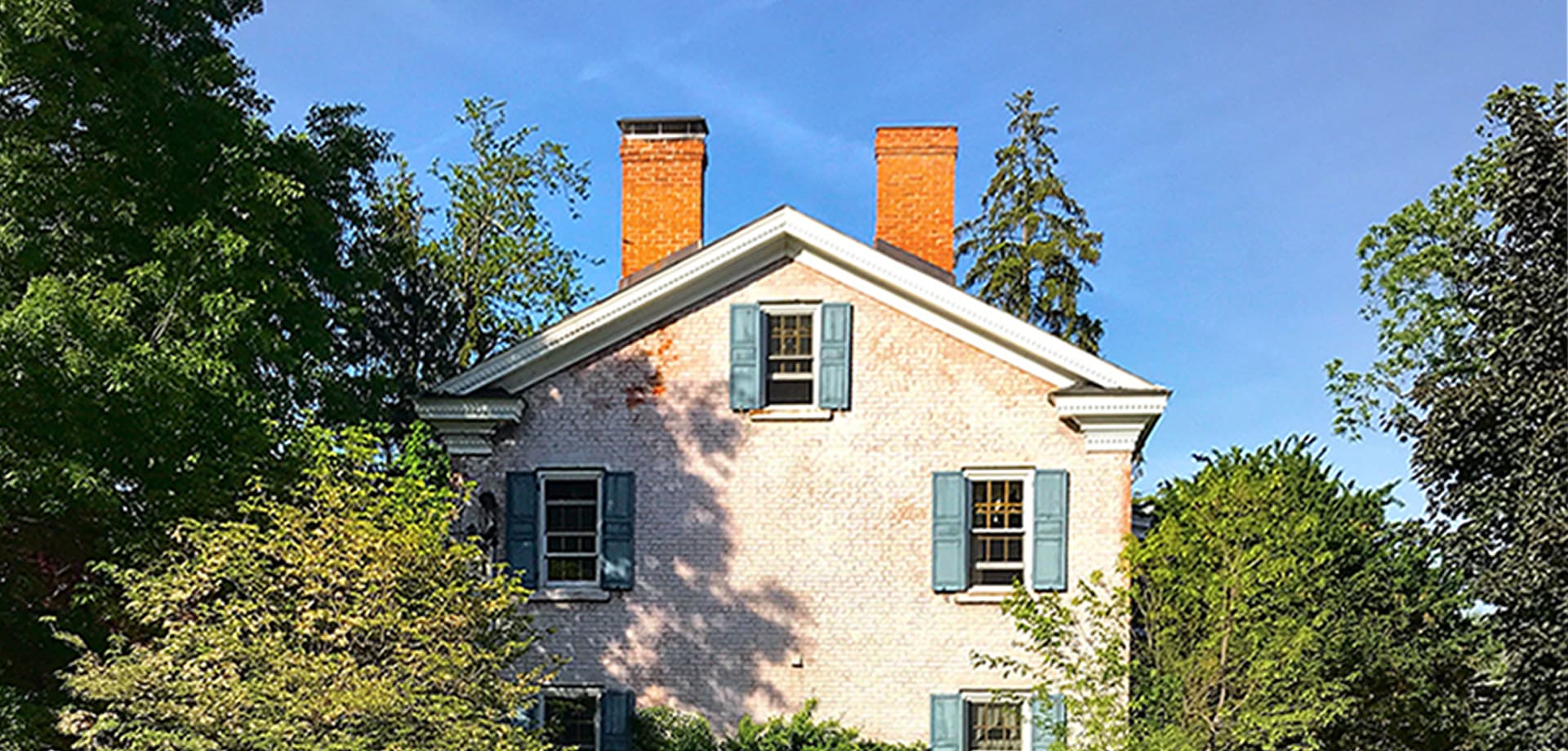
Chimney Safety Tips
Buckle up and get ready for an overload of Chimney Safety Tips! Starting with the MOST critical thing you can do: Check how long it’s been since your last fireplace inspection.
If it has been over a year since a chimney sweep serviced your system, then it is time to call the inspector for a chimney check-up and flue cleaning.
TABLE OF CONTENTS
- Fire Prevention Tips
- Do Not Burn These Items
- Know the Signs of a Flue Fire
- Do Not Use Fire to Clean a Chimney
- DIY Creosote Logs vs Hiring a Pro
- Tips for Safely Using a Fireplace
- Things to Do BEFORE You Start a Fire
- Tips for Choosing the Right Firewood
- Understand Liners and Draft Issues
- Check for Blockages to Stay Safe
Learn How to Prevent Chimney Fires
It is possible to stop a flame from igniting and becoming a full-blown fire in your chimney stack. Here are a few tips to maintain your home’s safety and prevent a fire from happening in your flue.
- Use dry, seasoned firewood so the wood sparks and pops a lot less. Check out the information and video on our firewood page about burning green or damp.
- Build and maintain your fire and grate to the rear half of the firebox to help with unwanted smoking and draft.
- Avoid sparks from your fireplace. Sparks and embers bouncing around your fireplace is part of enjoying a wood fire, but you must take the steps to responsibly “keep fire in its place.”
- Use a spark screen and keep it drawn except when adding wood or “dressing” the fire.
- For fireplaces with doors, consider closing them if you must leave the fire unattended for a brief moment.
REMEMBER: The annual cleaning and inspection is your first and most crucial step in preventing the risk of fire or carbon monoxide in the home. Visit our Chimney Inspections page to learn more.
Avoid Burning the Wrong Objects
Some things should never be put into a fireplace or stove. Consider these critical home safety tips during the burning season. Here are a few things to avoid while using your fireplace.
Flammable Liquids
Never burn any flammable liquids like fuel, oil, or alcohol in your firebox. Not only do they burn fast and hot, they could drain to the areas beneath the fireplace, leading to fire reaching adjacent combustibles.
Fast Burning Items
Anything that will burn too fast could cause flames to leap to the top of your fireplace. Doing this could lead to damage, smoking, smell, and maybe even a house fire—paper products of any kind such as:
- A whole newspaper
- Trash or garbage items
- Even one pizza box is enough to set a dirty chimney flue on fire.
If you need to destroy sensitive documents (tax records, for example), shred them instead.
Trees
If you have a real Christmas tree, dispose of it properly, never cut it up and try to burn it. Pine and Spruce trees contain flammable sap, and their needles burn like a thousand match sticks igniting all at once.
Other Items
Any human-made items like fabric, rubber, plastics, and other combustible manufactured items not only burn too hot and fast, they will leave a foul smell that will last long after the fire is out.
Realize Flames Can Be Too Big!
While a fireplace is “a place for the fire,” we can have too much of a good thing. Every fireplace has a heat tolerance. If exceeded, bad things begin to happen. For example: A sustained large (hot) fire will damage costly fireplace parts. The damper, firebrick, smoke chamber, and flue liner all have a limit (both in time and temperature) of heat before they began to crumble or warp.
Our suggestion, add only limited amounts of quick-burning wood (kindling) to the fireplace when starting a fire. If burning a manufactured fire log, “Dur-a-log” or brand, be careful not to poke at it once it starts burning. Doing so could cause the log to break into pieces and try to burn all at once, producing a vast and scorching fire.
Understand Chimney Height to Roof Matters
If the chimney top is too close to the roof, sparks can catch nearby combustibles on fire. Chimneys should be at least 10 feet in overall height. Where it projects above the roof, the chimney should be at least 3 feet tall, and at least 2 feet higher than anything within 10 feet of it – including other buildings. Trees too close to the chimney can even affect safety. For more information about the importance of Chimney height, visit our Chimney and Fireplace Anatomy page.
Recognize the Signs of a Chimney Fire
Witnesses who have survived a chimney fire report several signs, alerting them something terrible was happening! In no particular order here are a few of the common signs to help you recognize a fire could be occurring in your flue:
- If you hear a low to loud roaring sound, it could be creosote rapidly burning as the chimney pulls in large amounts of air.
- The smell of burning metal. Similar to that of a new gas grill or an empty frying pan getting hot.
- Report of visible flames and sparks visible at the top of the chimney. In some instances, embers and sparks can be seen flying out onto the roof or lawn.
- A sound like cracking glass happens when clay flue tiles are heated too quickly, as they are expanding so fast that they break.
- The exterior of your fireplace and chimney become extremely hot! This heat transfer is another reason chimney fires lead to house fires. If the home construction has combustibles too close to the chimney’s exterior, then framing and siding will get hot enough to ignite.
Still not convinced about the seriousness of these fires? Read this story about a Kansas City family losing their home due to a chimney fire.
TIP: If you ever think you have a chimney fire, then call 911. Immediately gather all household occupants and get outdoors to safety.
NEVER Use a Chimney Fire to Clean Your Flue
Would you believe some folks encourage a chimney fire as a means of “removing” creosote and soot from their chimney? We hear it all the time and still can’t believe it! It is a dangerous myth.
While your flue might appear cleaner at a glance, it often gives the chimney too much of a good thing, leading to expensive repairs or worse. For example: Two consequences are water leaks or carbon monoxide seeping through cracks in flue tiles caused during a fire.
TIP: NEVER try to burn the creosote out of your chimney. Instead, call your Certified Chimney Sweep Every Year.
You Need a Creosote Remover That Works
With frequent reports of creosote leading to fires in fireplace chimneys, it’s a given that removal is urgent. There are many ways to go about this, some are DIY, and others take a professional’s help.
Products like the sweeping log offer hope of merely placing it in the fireplace, and while it burns, chemicals are reacting with the harsh substance, causing creosote to loosen and fall into the fireplace. Like many other consumer products that promise “Just add this, and all your problems go away!” these miracle cures may lessen the problem slightly but, more often than not, barely help at all.
DIY Cleaning Log vs Hiring a Pro
The best way to remove creosote is to AVOID it in the first place. Proper operation of a stove or fireplace using seasoned wood means only a small amount of soot and creosote will build up. A proper liner system (as discussed above) will drastically reduce the build-up as well.
Professionals have access to modern tools and know techniques that most homeowners and DIYers do not. Pros do this work every day. By getting a CSIA Certified Technician to service your system, you’ll have the added peace of mind. Getting the fireplace and flue inspected helps catch safety issues before they turn into expensive, dangerous problems. Watch this flue fire simulation video to understand the dangers of getting your chimney properly cleaned.
TIP: Hiring a Certified Professional in your area to clean the burning system annually is the only surefire way to keep creosote from causing you and your chimney major problems.
Learn How to Safely Use Your Fireplace
Successful fire-building in your fireplace starts with some simple preparation. The key is getting your fireplace and firewood prepared.
Excessive ash under your grate will limit the amount of fresh air for combustion the fire will get. Be sure to clean out the firebox ash if it’s over an inch thick. At this time, take a look at the fireplace damper. Is it opening fully? This swell will increase the draw of smoke out of the home and air into the fire. Learn how Full Service Chimney will safely remove your fireplace ash for you on our fireplace ash dump service page.
Look for a build-up of soot and creosote in the area of the damper and flue. If it’s over 1/8 inch, we’re risking a chimney fire, and this build-up will limit the amount of smoke that can draft up the chimney. Skip the fire today and schedule a chimney cleaning. It will make fire building easier and keep your chimney and home safer.
REMEMBER: Never leave a fire unattended. Even as it’s going out, that could be the time when a chimney fire ignites. There’s also the potential for children to get hurt from hot surfaces.
For more fire building tips, see our method of the upside-down fire; you’ll be a successful wood burner in no time!
Fireplace Door Warnings
- Two-sided fireplaces must be operated with both doors open or both doors closed. Operating a two-sided fireplace with one set open and one closed causes extreme heat against the closed set, which could break the glass of the fireplace doors on that side.
- Placing the grate closer than 6” from the doors can break your fireplace door glass.
Take Steps Toward a Safer Burning Experience
In addition to regular maintenance, there are a few steps you can take both inside and outside your home as precautionary measures to help you keep your fireplace as safe as possible. These recommendations should be considered far in advance to help prevent house fires. We’re talking Long BEFORE You Start a Fire in your fireplace!
OUTDOOR: Start by inspecting the top of your chimney before lighting a fire in the fireplace. If the chimney cap is damaged, it will affect how well the chimney drafts. Nearby objects like tree limbs will cause drafting issues and may even overheat and catch on fire.
Next, prepare your wood and make sure it’s properly seasoned and kept stored in a dry spot.
INDOOR: Make sure the outer hearth is non-combustible and is of proper size. Doing so protects the floor/carpeting in front of your fireplace. Your inspector should let you know if everything is set up correctly and to code.
Remove any decorations (or other objects) near your fireplace before starting any fires. During burning in your fireplace, be aware that nearby combustibles, within line of sight of the flames, will get very hot (similar to space heaters) and could ignite solely from the radiant heat! Visit our How to Decorate Your Fireplace Safely post for the best fireplace decoration tips.
Burn Only Certain Types of Wood
All firewood was formerly a living tree; therefore, it all contains moisture. Too much water in firewood causes several problems and could even lead to a chimney fire. Burn only split and seasoned hardwoods with a moisture content between 20-25%. If wood logs contain too much water, your fire will burn smokey. It’s this smoke that leads to more excessive creosote build-up than would generally occur when using well-seasoned firewood.
Creosote is like fuel for dangerous fires and must be avoided to maintain a safe hearth and home. It’s important to understand that ANY fireplace that has EVER burned wood is subject to a chimney fire. People often assume that switching from wood burning to gas logs will solve their problems. In reality, the danger remains present.
The reason is because the creosote and soot from earlier are likely still coating the flue tiles inner walls. A chimney fire always ignites from a fire in the fireplace. Even a quick small fire could be the one that sets your whole chimney on fire!
TIP: Avoid over-firing the fireplace or wood stove. Any fire that reaches the top of a fireplace puts out a tremendous amount of heat and sparks right up the flue.
Understand a Liners Role in Home Safety
If our chimney has a compromised or, worse, missing flue liner, then the byproducts of combustion (such as carbon monoxide) can find their way to areas that can harm us.
Draft Matters
Fireplaces without liner systems do not draft well, making fire building a real chore. In some cases, a damaged chimney flue liner will leak in air. When this happens, it makes the ability to draw smoke from the fireplace impossible. The same happens with a furnace, but it’s a deadly gas that cannot escape instead of smoke.
The DRAFT in a liner is the force that pulls in combustion air for the fireplace, wood-stove, or furnace, ensuring that these household appliances perform correctly.
Finally, in the event creosote catches a spark and ignites into a flue fire, the chimneys liner is the part that keeps the fire from spreading to the nearby home. If it’s damaged (gap, cracks, or missing entirely), it poses an avoidable risk of fire spreading from the chimney to the house.
Install New Stainless Liners to Help Keep Your Family Safe & Sound
Chimneys with damaged or missing liners are a significant hazard. And one people often don’t know about until it’s too late, but it’s a safety concern that we can all live without!
Like tires for a car, shingles on a roof, locks on a door, so too is the liner in your chimney. We often don’t give them a thought… until we need it. But understand that’s the wrong way to look at it. We must stay on top of fireplace and flue liner maintenance; for the same reason, people shouldn’t drive on bald tires; it’s dangerous.
It’s the chimney’s flue liner that has the job of carrying the smoke, heat, and creosote to the outdoors, away from the home. Helping you keep a safe environment for a thriving home life.
REMEMBER: Chimney liners are a system, quickly installed, and can last a lifetime. If your liner is damaged or missing, then don’t wait. Stop using your fireplace or furnace until it’s repaired.
Beware of Flues Becoming Blocked or Clogged
Chimneys, when built well, constructed with proper materials, can last a very long time (with regular maintenance). But, these structures are subject to wear and tear deterioration over time and use like everything else.
Since a chimney is like a hollow box, with openings both at the bottom and top, they are subject to wear and tear damages inside and out.
If a chimney begins to crumble or animals enter to build a nest, the opportunity for blockages is not just a possibility but becomes a dangerous likelihood. Loose chimney debris rarely falls all the way down to the fireplace without catching on ledges or shelves inside, causing a pile of twigs, bricks, mortar to close off the flue. Almost always, this happens without homeowners noticing until there is a problem.
Tips to Help Discover and Prevent Blockages in Your Chimneys and Fireplaces
Be vigilant to observe the drafting of your fireplace or gas furnace chimneys. Smoke starting to come from the fireplace or the alert of a carbon monoxide detector may be the only warning signs that the exhaust is not making its way out the chimney top.
If you find small pieces of brick or mortar on the damper or firebox floor, know this is a sign that the passageway is crumbling. Not only is this a concern, there could be a blockage, but it may also indicate that the chimney has voids (holes or gaps) that may allow dangerous exhaust inside the home.
Listen for sounds of animals or birds coming from your chimney flues or vent pipes. Natures little critters are always seeking shelter for their families, and if they can make their way into your chimney, then they will. For example, birds will use a bale of hay to “feather their nest,” which will block the chimney flue, creating a fire hazard. Read this post to learn how to prevent birds from entering your chimney!
The Best Defense is a Good Offense
The best protectors for your home against future blockages are chimney caps and annual inspections.
The cap will not only keep pests out but also shed rain and snow away. Exposure to seasonal elements can accelerate damage to water sensitive chimney parts.
The inspection will help you make sure you’re aware of any deterioration and blockages when they’re first starting. Not when it’s too late!
Hey there,
Thanks so much for reading and taking your first steps toward having a safe fireplace and chimney in your home! Why don’t you head over to the blog and see what else you can find…
Our Memberships & Accreditations

Suggested Reading:
Learn more more about us why it's critical to Choose a Certified Chimney Sweep for your project!


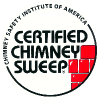

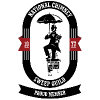
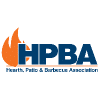



Get Safety Tips from Your Local Certified Pros
Our customer service team is ready to help with the best safety tips to improve the enjoyment of your homes fireplace and chimney system.
